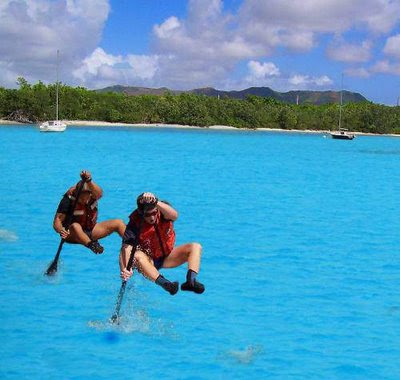Welcome to Wallpaper Hungama, the home of cool backgrounds and high definition wallpapers. We offer thousands of quality wallpapers free for download.
Monday, June 30, 2008
Saturday, June 28, 2008
10 Most Beautiful Stunning Bridges Around The World

Bridges have long been a thing of fascination in the human mind because of what they connote: connection. Even though much of our communication is carried out via email or telephone, we are still nonetheless a sociable bunch. We go places, see things, visit people and experience life, all of which requires movement and interaction. Bridges are therefore a facilitator of connection in the broad mesh of human social life.
Continuing on from our previous exploration of 18 stunning bridges, we take a further look at 10 more of the oldest, newest, biggest and best bridges in existence today from around the globe.
Stari Most, Mostar

Stari Most: Commissioned originally by Suleman the Magnificent in 1557, Stari Most connects the two parts of the city of Mostar in Bosnia-Herzegovina, crossing the River Neretva. In 1993, during the Bosnian War, the bridge was destroyed by the Croatian Council of Defence, however its reconstruction was completed in 2004 and the bridge still stands proud today.
Popular with locals and tourists alike as a platform to dive from, the bridge is 24m above the river below, 4m wide and 30m long. It is supported by two limestone abutments which connect to wing walls along the water cliffs, each erected to a height of 6.53m. The unusual hump shape of the bridge is claimed to be caused by buckles in the inner arch, allowing for its unique and photogenic appearance.
Verrazano-Narrows Bridge, New York City

Verrazano-Narrows Bridge: Named after Giovanni da Verrazano, the first man to sail into New York Harbour, the Verrazano-Narrows bridge connects Brooklyn and Staten Island, and was the world�s longest suspension bridge upon completion in 1964. Each of the enormous towers weighs 27,000 tonnes, and they are further apart from one another at their tops than at their bases, as the 4,260ft distance between them forced construction to compensate for the earth�s curvature. However, it is the steel cables which allow for the more interesting reading, as the expansion of the metal makes the bridge a full 12ft lower is summer than in the winter months.
Mackinac Bridge, Michigan

Mackinac Bridge: The Mackinac Bridge, often referred to affectionately as �Mighty Mac� or �Big Mac�, connects the Upper and Lower Peninsulas of the US State of Michigan, and its 8,614 feet suspended length makes it the longest suspension bridge in the Americas. Although the bridge itself is just over half a century old (construction having been completed in 1957), plans to cross the straits of Mackinac originally emerged as a reaction to the opening of the Brooklyn Bridge in 1883, with locals happy to facilitate easier crossing of the waters.
Two years after the $99.8 million construction was completed, US Air Force pilot Captain John Lappo lost his flying privileges after taking his plane underneath the bridge, its 200m vertical clearance violating rules on flying altitudes. For a slightly safer (and legal) way to enjoy the view, the bridge functions as a $3 toll for Interstate 75 today.
Confederation Bridge, Canada
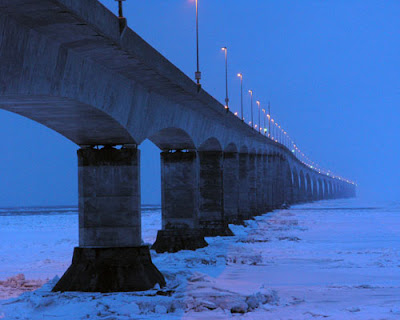
Confederation Bridge: Although aesthetically the Confederation Bridge may not be able to compete with other bridges on the list, its size and the amount of effort which went into its construction more than make up for its physical beauty. The idea to cross the Northumberland Strait with a �fixed link�, as opposed to the increasingly inefficient ferry service, had been around for a number of years, but it wasn�t until the 1980s that plans began to develop to link Prince Edward Island and New Brunswick.
The bridge was finally completed in 1997, at a total cost of $1.3 billion. It is supported by 62 piers, the majority of which keep the bridge around 40 metres above sea level, although there is a 60m peak which allows shipping traffic to pass underneath. The bridge will be managed privately until 2032, when management will be handed over to the Government of Canada.
The Sunshine Skyway Bridge, Tampa Bay

The Sunshine Skyway Bridge: With its 5.5 mile length, the Sunshine Skyway Bridge in Florida is the longest cable-main stayed bridge in the world and cost an enormous $244 million to build, construction being completed in 1987. This steel and concrete structure is supported by 12 steel cables, each one clad in 9 inch steel tubes. However problems arose when the steel inside the concrete precast segments began to corrode, but workers were able to get inside the hollow segments and provide vital reinforcement.
In 1980, a freighter collided with one of the bridge�s support columns, causing a section of the bridge to collapse into Tampa Bay, sending six cars and a Greyhound bus into the water from a height of 150 feet. Of the 36 people involved, only one survived, although he did managed to sue the freight company for a hefty $175,000!
New River Gorge Bridge, West Virginia

New River Gorge Bridge: Built in 1974, the New River Gorge Bridge is the world�s second highest vehicular bridge, second only to the Milau Viaduct in France. It�s unpainted steel appearance may not make it that spectacular to look at, but it saves what would have been the $1 million needed to regularly repaint bridge, and more often than not, it�s not the bridge you find yourself looking at.
876 feet above the New River rapids, the bridge is 3,030ft long and offers spectacular views of the gorge below, one of the largest draws for those who flock to the bridge on the third Saturday of October each year to celebrate �Bridge Day�, an annual tradition which halts Highway 19�s traffic for the day as base jumpers and abseilers take full advantage of the picturesque location for an adrenaline rush.
Chesapeake Bay Bridge Tunnel, Fayetteville

Chesapeake Bay Bridge Tunnel: Although not strictly a bridge on its own, the Chesapeake Bay Bridge Tunnel (CBBT) simply has to be included because of its sheer size and engineering prowess; it was labelled as �One of Seven Engineering Wonders of the Modern World� in 1965. Stretching to around 23km, CBBT is the primary way of crossing the mouth of the Chesapeake Bay, and connects Virginia Beach / Norfolk with Virginia�s eastern shore via a series of bridges and tunnels.
Construction began in 1960, to be completed 4 years later, and the $200 million project was funded completely by private toll revenue bonds. In 1995, for almost the same cost as the original project, new two-lane parallel trestles were added to decrease traffic volume, although plans to replace the two underwater tunnels were scrapped as cost estimations came in at an enormous $900 million.
Rio Antirio Bridge, Greece

Rio Antirio Bridge: If ever a construction deserved recognition for the sheer difficulty of the task, the Rio Antirio bridge in Greece must be it. It is impressive in itself that is boasts the second longest cable-stayed deck in the world at 2.252m, beaten only by the Millau viaduct in France, but such an achievement is only enhanced by the conditions placed on the construction. The piers which support the bridge could not be buried in the 65m deep seabed, made up of mostly loose sediment, thus a painstakingly levelled bed of gravel was laid under water to provide something for them to rest on. The risk of seismic activity and tectonic plate movement also had to be taken into account, with the piers able to move laterally underwater in the event of an earthquake allowing the gravel beds to absorb the vast majority of the shock.
The parts of the bridge itself are connected using jacks and dampers, allowing for movement of the parts during an earthquake without seriously damaging the bridge structure itself. Opened just in time for the Athens Olympics in 2004, the bridge is perhaps one of the most spectacular of its kind as far as engineering is concerned in the world.
Brooklyn Bridge, New York City

Brooklyn Bridge: Upon its completion in 1883, Brooklyn Bridge was the largest suspension bridge in the world, and was generally considered as one of the most technically spectacular achievements of the day. The bridge soon developed into a vital transport link between Manhattan and Brooklyn, and is still used extensively today with over 140,000 people crossing the bridge, whether it be in the car or on foot, on a daily basis.
The bridge was originally designed by prolific German bridge designer John Augustus Roebling and is generally considered as his greatest achievement, although he didn�t actually live to see the bridge completed. Ill health also disabled his son, Washington, who inherited the project from his father, and it was left to Washington�s wife, Emily, to oversee project completion. Roebling�s design legacy however was vital in the bridge�s longevity; he designed the bridge �six times stronger� than it needed to be, which is why it remains fully functioning today, 125 years after construction finished, when other bridges of the same era built with a similar lack of technology have perished.
Puente del Alamillo, Seville

Puente del Alamillo: Easiest translated into English as �The Alamillo Bridge�, Puente del Alamillo crosses the Canal de Alfonso XIII in Seville, and was built to provide access to La Cartuja island, the site of the World�s Fair in 1992. Designed by Spanish architect Santiago Calatrava, the bridge is noted for its striking design, a huge pylon which, with the aid of 13 connecting cables, counterbalances the 200m main bridge span.
The bridge is renowned for looking particularly spectacular at night time when lit up, and is supposed to represent the �soaring aspirations� of the city itself. Originally, the bridge was designed as half of a pair, the symmetrical reproduction of the current construction to go at the other end of the island. However, designers decided the current one pylon construction was more spectacular aesthetically, and the sister bridge was abandoned.
14 Simple Ways to Super Charge Your Brain

Have you ever felt exasperated when you bumped into someone at the store but absolutely couldn't remember their name? Sure, it happens to all of us.
Despite being the strongest computer on the planet, our brains do lapse. It's hard to blame them really. As humans, we spend much of or existence stuffing our brains with stuff. Some stuff is worthless, some of it's meaningful, some of it, well, it's just stuff and there is an endless amount of it.
No matter how powerful our brains are, they need recuperation time, to be kept in shape, and even an occasional charge. Think of it as a tune up for your brain. Skipping brain maintenance is as silly as the person wandering the parking garage because they forgot where they parked. Is that you? Are you that person? Sure. We all are at some point. No worries, there is hope.
Now I am not a brain surgeon and I am not going to suggest you do anything surgical or dangerous. I am however an astute student of human behavior, so I always look for simple ways to super charge my brain.
Here are some things you can begin doing as soon as today to begin the great brain tune up.
1. Eat Almonds
Almond is believed to improve memory. If a combination of almond oil and milk is taken together before going to bed or after getting up at morning, it strengthens our memory power. Almond milk is prepared by crushing the almonds without the outer cover and adding water and sugar to it.
2. Drink Apple Juice
Research from the University of Massachusetts Lowell (UML) indicates that apple juice increases the production of the essential neurotransmitter acetylcholine in the brain, resulting in an increased memory power.
3. Sleep well
Research indicates that the long-term memory is consolidated during sleep by replaying the images of the experiences of the day. These repeated playbacks program the subconscious mind to store these images and other related information.
4. Enjoy simple Pleasures
Stress drains our brainpower. A stress-ridden mind consumes much of our memory resources to leave us with a feeble mind. Make a habit to engage yourself in few simple pleasures everyday to dissolve stress from your mind. Some of these simple pleasures are good for your mind, body and soul.
* Enjoy music you love
* Play with your children
* Hug a stranger
* Appreciate others
* Run few miles a day, bike or swim
* Start a blog
* Take a yoga class or Total Wellness routine
5. Fast for a day
Fasting cleans and detoxifies our body. It is known fact that heavy food not only causes stress on our digestive system but also drains our brainpower. Fasting relieves toxic emotions such as anger, grief, worry, and fears - before they accumulate and cause disease. By cleansing toxic emotions, fasting strengthens metal clarity with increases memory, concentration, creativity and insight.
6. Exercise your mind
Just as physical exercise is essential for a strong body, mental exercise is equally essential for a sharp and agile mind. Have you noticed that children have far superior brainpower than an adult does? Children have playful minds. A playful mind exhibits superior memory power. Engage in some of the activities that require your mind to remain active and playful.
* Play scrabble or crossword puzzle
* Volunteer
* Interact with others
* Start a new hobby such as blogging, reading, painting, bird watching
* Learn new skill or a language
7. Practice Yoga or Meditation
Yoga or Meditation relives stress. Stress is a known memory buster. With less stress, lower blood pressure, slower respiration, slower metabolism, and released muscle tension follows. All of these factors contribute significantly towards increases in our brainpower.
8. Reduce Sugar intake
Sugar is a non-food. It�s a form of carbohydrate that offers illusionary energy, only to cause a downhill slump once the initial burst has been worn off. Excess intake of sugar results in neurotic symptoms. Excess sugar is known to cause claustrophobia, memory loss and other neurotic disorders. Eat food without adding sugar. Stay away from sweet drinks or excess consumption of caffeine with sugar.
9. Eat whole wheat
The whole wheat germs contain lecithin. Lecithin helps ease the problem of the hardening of the arteries, which often impairs brain functioning.
10. Eat a light meal in the night
A heavy meal at night causes tossing and turning and a prolonged emotional stress while at sleep. It�s wise to eat heavy meal during the day when our body is in motion to consume the heavy in-take. Eating a light meal with some fruits allows us to sleep well. A good night sleep strengthens our brainpower.
11. Develop imagination
Greeks mastered the principle of imagination and association to memorize everything. This technique requires one to develop a vivid and colorful imagination that can be linked to a known object. If you involve all your senses - touching, feeling, smelling, hearing and seeing in the imagination process, you can remember greater details of the event.
12. Sex
Our sexual imagination often empowers our ability to daydream, which strengthens our brainpower with greater imagination, visualization and association.
13. Control your temper
Bleached food, excess of starch or excess of white bread can lead to nerve grating effect. This results in a violent and some time depressive behavior. Eat fresh vegetables. Drink lots of water and meditate or practice yoga to relieve these toxic emotions of temper and violent mood swings.
14. Take Vitamin B-complex
Vitamin B-complex strengthens memory power. Eat food and vegetables high in Vitamin B-complex. Stay away from the starch food or white bread, which depletes the Vitamin B-complex necessary for a healthy mind.
I don't believe these are that tough. If you find yourself increasing stumped, give a couple of these a try.
Thursday, June 26, 2008
Wednesday, June 25, 2008
Incredible Soap Bubble Foto To Achieve Like Planet
I don�t see anyone else out there catching the most simple images of the world and having them look so beautiful.

Incredible Soap Bubble Photos by Jason Tozer
An old coat hanger bent into a wire loop and a good recipe for bubble mixture - some of the hi-tech essentials for producing great images


�I looked online for bubble recipes and a bit of glucose is apparently the key,� says Tozer. �Ten parts water, one part washing-up liquid and a little bit of glucose. We also used distilled water as well because hard water isn�t so good.�
Tozer�s first experiments produced several close-ups of elongated bubble shapes. Poised in front of a black background, his assistant was charged with bringing the detergent-loaded hoop through the air in front of the camera. Only occasionally would the bubble pass by the correct position�
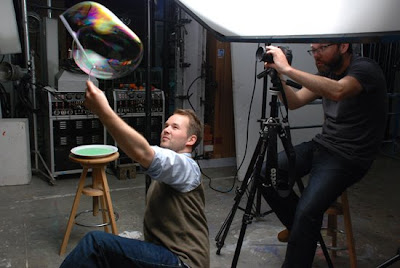
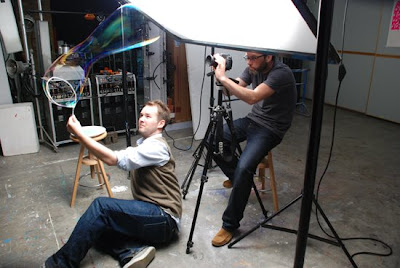

To achieve the more planet-like images, Tozer began by blowing through a straw into a plate of the solution and turning the camera on what formed on the near-side of the dish.



Interestingly, Tozer found that as further bubbles were made from a particular batch of solution, less colors appeared on the surface. �The first bubble you make has loads of colour in it, when you make another couple they seem to have less detergent in them, so less colour,� he says. �The detergent sinks to the bottom of the bubbles, leaving the water behind, so you gradually get paler images.�
For example:

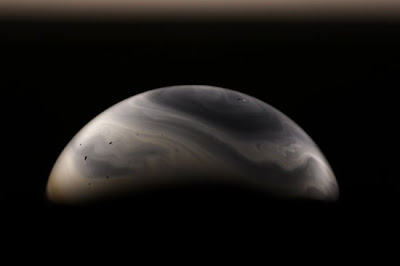

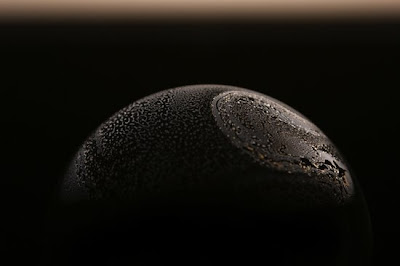
As for the settings on the camera itself � Tozer kept it all to manual. �I was trying to get the highest shutter speed we could, with the lowest ASA, so the shots were less grainy,� he says. �When we got some beefier lights we were able to go down to about 100 and then 200 ASA.�
What seems most remarkable about Tozer�s shoot is how a seemingly transparent film of liquid actually revealed a whole multitude of colors when caught in mid-air and photographed. Because of this Tozer was able to play around with scale and perspective and create a fantastic series of otherworldly pictures.
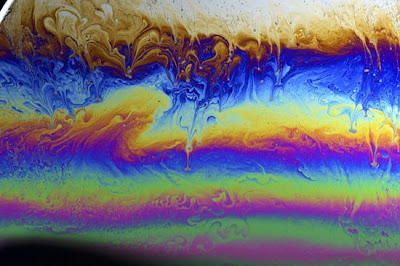

Incredible Soap Bubble Photos by Jason Tozer
An old coat hanger bent into a wire loop and a good recipe for bubble mixture - some of the hi-tech essentials for producing great images


�I looked online for bubble recipes and a bit of glucose is apparently the key,� says Tozer. �Ten parts water, one part washing-up liquid and a little bit of glucose. We also used distilled water as well because hard water isn�t so good.�
Tozer�s first experiments produced several close-ups of elongated bubble shapes. Poised in front of a black background, his assistant was charged with bringing the detergent-loaded hoop through the air in front of the camera. Only occasionally would the bubble pass by the correct position�



To achieve the more planet-like images, Tozer began by blowing through a straw into a plate of the solution and turning the camera on what formed on the near-side of the dish.



Interestingly, Tozer found that as further bubbles were made from a particular batch of solution, less colors appeared on the surface. �The first bubble you make has loads of colour in it, when you make another couple they seem to have less detergent in them, so less colour,� he says. �The detergent sinks to the bottom of the bubbles, leaving the water behind, so you gradually get paler images.�
For example:




As for the settings on the camera itself � Tozer kept it all to manual. �I was trying to get the highest shutter speed we could, with the lowest ASA, so the shots were less grainy,� he says. �When we got some beefier lights we were able to go down to about 100 and then 200 ASA.�
What seems most remarkable about Tozer�s shoot is how a seemingly transparent film of liquid actually revealed a whole multitude of colors when caught in mid-air and photographed. Because of this Tozer was able to play around with scale and perspective and create a fantastic series of otherworldly pictures.
























